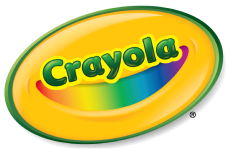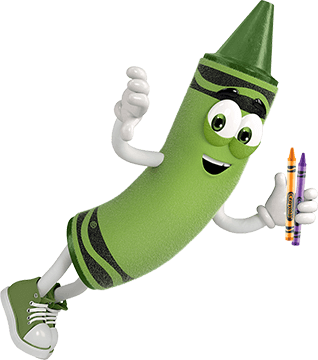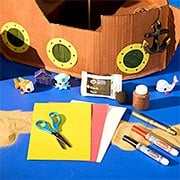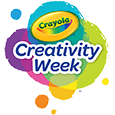Valoramos su compromiso con el reciclaje de los productos que ya no utiliza.
En Crayola, nuestro objetivo principal es proporcionar productos seguros y de alta calidad. Para mantener los estándares de seguridad y rendimiento que nuestros clientes esperan, seleccionamos y seleccionamos cuidadosamente las materias primas para nuestros crayones. Desafortunadamente, la introducción de cera de crayón reciclada en nuestro proceso de fabricación comprometería estos estándares.
¿Buscas formas creativas de reutilizar tus lápices de colores rotos? Explora nuestras coloridas técnicas de arte de crayón derretido.
Crayola está comprometida con la sostenibilidad y la responsabilidad medioambiental. Para obtener más información sobre nuestros esfuerzos para apoyar un planeta más verde, visite nuestra página de sostenibilidad.
Si tienes preguntas adicionales, ¡nos encantaría saber de ti! No dudes en llamarnos o enviarnos un mensaje de texto al 1-800-CRAYOLA días laborables entre las 9 AM y las 4 PM hora del Este. Si prefieres enviarnos un correo electrónico, visita nuestra página de contacto.
Preguntas relacionadas
Explora respuestas a preguntas comunes, consejos útiles para eliminar manchas e ideas creativas para aprovechar al máximo nuestros materiales de arte y recursos gratuitos.
-
Introduced in 1998, Crayola® offers a variety of colored pencil assortments that are the essential creative tool for kids or the art enthusiast. Crayola colored pencils are manufactured in Brazil, Costa Rica or Vietnam due to their high-volume manufacturing capabilities.
The process of making Crayola Colored Pencils begins in the forest. Seedlings, which are young trees, are planted in fields much like a farmer plants a crop. Seedling crops grow into trees which are eventually used to make wood casings for the pencils. After several years, the trees are harvested, cut into even lengths, stacked onto trucks and shipped to the sawmill. Then, a new crop of seedlings is planted to replace those which have been harvested.
At the sawmill, lumber arriving by the truckload is stacked in large piles and allowed to dry. Once dry, the lumber is fed into a bark stripping machine which removes all the bark from each piece of lumber. Next, the lumber goes through a series of milling machines which cuts the lumber into rectangular slats. These slats are about as long as a colored pencil and about three inches wide. The slats are the building blocks for the production of colored pencils.
The slats are then transported to the pencil making plant. Here they are fed into another milling machine which cuts small semicircular grooves at regular intervals down the length of each slat. These grooved slats are now ready to accept a colored pencil core.
To make a Crayola Colored Pencil core, you need four raw materials:
- Extenders - which make up the body of the lead.
- Binders - to hold the ingredients together.
- Pigment - which gives each type of colored pencil its unique color.
- Water – to mix all the ingredients.
First, the extenders, binders, pigments and water are placed in a large mixer which gently kneads them together into a uniform doughy substance. When the mixing is complete, the contents of the mixer are rolled into flat sheets. Finally, these sheets are machine-pressed into large, long solid cylinder shapes. These shapes are called cartridges.
Each cartridge, while still damp and pliable, is inserted into another machine called an extrusion press, where it is forced through a small tube. The tube has a diameter equal to that of a colored pencil core. As the long rope of wet colored core comes out, an automatic slicer cuts it into equal lengths approximately as long as a colored pencil. Since the leads are still quite moist, they must be dried in large ovens before they become hard enough to insert into the slats.
To assemble the pencils, half of the grooved slats are fed into a machine which carefully lays a colored pencil core into each groove. Then a layer of glue is applied, and a second grooved slat is placed on top of the slat holding the lead. Think of this as a pencil sandwich, with each slat acting like a piece of bread and the color cores acting like the filling.
These pencil sandwiches are then bound very tightly together and placed into storage to give the glue time to dry. Once the glue is dry, they are fed into another milling machine which cuts them into individual colored pencils. Depending on the design of colored pencils, they are cut into either round or hexagonal shapes.
Next, the pencils are fed into a machine to be painted with the same color paint as the colored core. The pencils run down a conveyor belt to allow the paint to dry. The painted pencils are then sent to a machine to be automatically sharpened.
Finally, brightly colored finished pencils are packed into boxes, which are shipped to neighborhood stores.
Crayola Colored Pencils are used by people of all ages for everything from crafts to professional artwork and school projects. Learn more about Crayola Colored Pencils products.
-
We currently use 12 different colored labels for CRAYOLA Crayons. The labels are purchased through an outside vendor and made of either vat dyed construction paper or printed paper and reforested wood. We manufacture more than 120 different Crayola Crayon colors, however, we do not have a crayon label to match each of these colors.
-
The basic ingredients contained in Crayola® Crayons are paraffin wax and color pigment. These ingredients are the same for all Crayola Crayon colors, with some modifications in special effects crayons.
Crayola Crayons begin to melt at around 105° Fahrenheit and have a melting point between 120° - 147° Fahrenheit. The melting point is the same for all regular Crayola Crayons; however, the density and amount of pigment included in different crayons will result in varying thickness or viscosity of the mixture.
-
While we don't manufacture a specific sharpener for Crayola® Colored Pencils, hand-held sharpeners are the optimal choice for achieving a precise point. We recommend them over electric or crank-style sharpeners. Hand-held sharpeners with dual holes offer versatility for most standard-size and larger pencils.
Recommended Sharpeners:
- Standard-size colored pencils: Brass Bullet Pencil Sharpener and Chubby Pencil Sharpener. You can view these sharpeners on the NASCO website or call 800-558-9595.
- Large-size Write Start Colored Pencils: Helix Hand-Held Sharpener with two holes. Find this product on Blick Art Materials using product code #21401-0100 or call 1-800-447-8192. Some eye pencil sharpeners from beauty supply stores may also work!
Note: Crayola Color Sticks don't need sharpening, but you can achieve a fine point with any handheld sharpener that has a 15mm opening.
-
Crayola® Crayons are made primarily from paraffin wax and color pigment. We do not recommend making candles using Crayola Crayons. They have not been tested or approved for this type of use. For craft ideas regarding melted crayons, please visit the DIY Crafts of our website, or to inspire creativity in children of all ages, check out our free, printable Coloring Pages.




